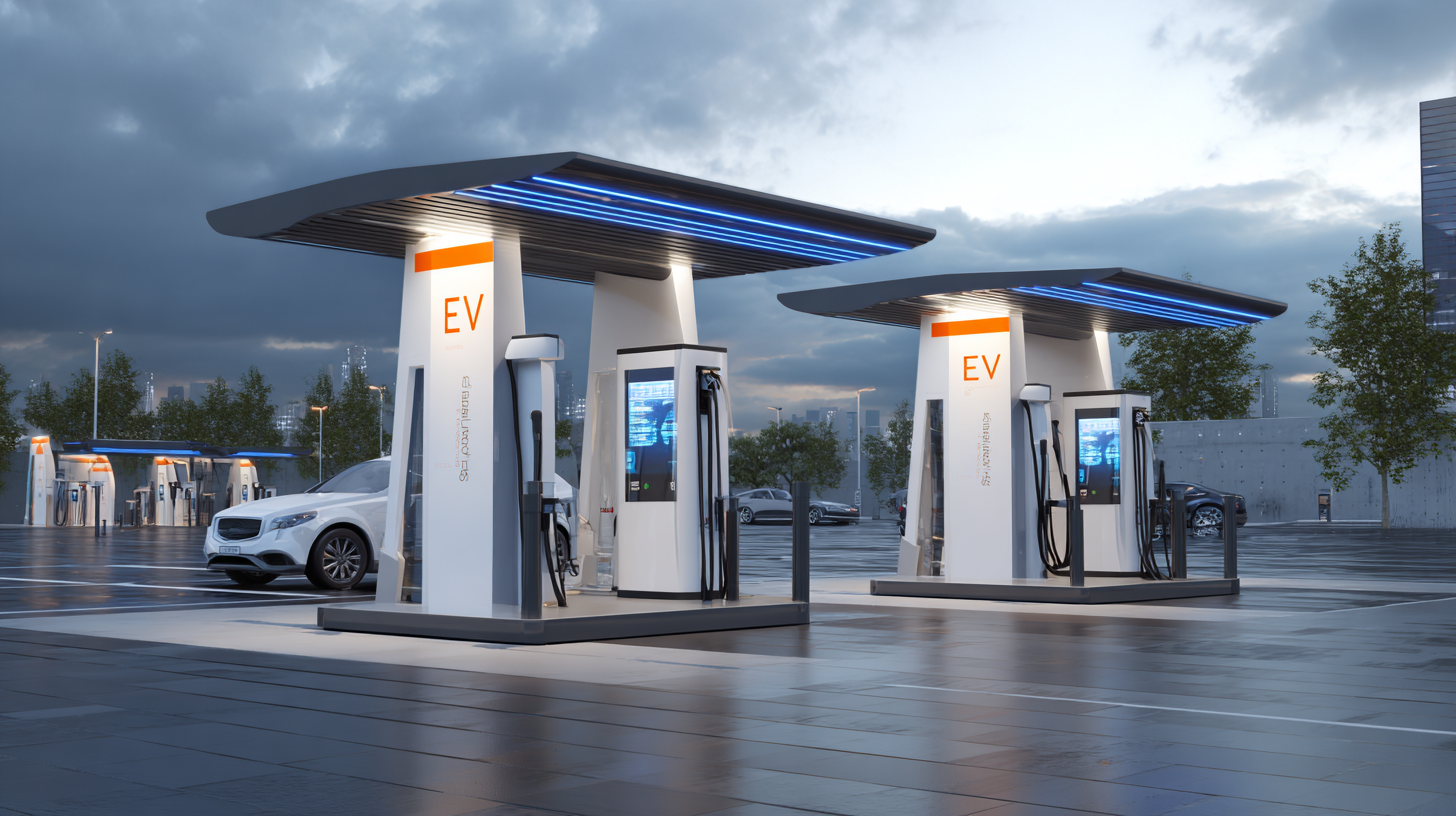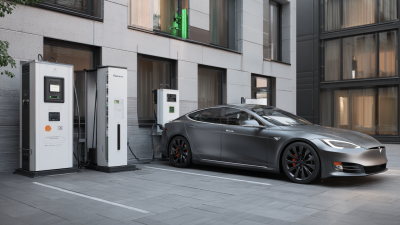
Wall Mounting EV Charge Station
Unlock the Future: How EV Charger Stations are Revolutionizing Sustainable Transportation
As the world pivots towards sustainable transportation, EV Charger Stations are at the forefront of this revolution, significantly impacting both consumer behavior and infrastructure development. According to a report by the International Energy Agency (IEA), the global number of electric vehicle (EV) charging points surpassed 1.8 million in 2020, showcasing a staggering growth rate of over 40% from the previous year. This trend is expected to accelerate, with projections estimating that by 2030, there could be nearly 10 million public charging stations worldwide. The increasing availability of EV Charger Stations is not only driving the adoption of electric vehicles, with sales expected to reach 30% of the global car market by 2030 but is also leading to enhanced energy management practices by integrating renewable energy sources. This evolution is pivotal for achieving carbon neutrality in the transportation sector, paving the way for a sustainable future where EVs become the norm rather than the exception.

Understanding the Technology Behind EV Charger Stations
Electric vehicle (EV) charger stations are becoming a pivotal element in the transition towards sustainable transportation. The technology powering these stations is designed to meet the growing demand for rapid and efficient charging solutions. According to a recent report by the
International Energy Agency (IEA), global EV sales reached 6.6 million units in 2021, highlighting the urgent need for robust charging infrastructure. Modern charging stations utilize Level 2 AC chargers and DC fast chargers to provide varying charging speeds. For example, a Level 2 charger typically delivers 10 to 20 miles of range per hour, while DC fast chargers can restore up to 80% of an EV's battery in just 30 minutes.
Tip: To maximize your EV's charging efficiency, consider using a smart charger that adjusts power output based on your vehicle's needs and the grid's demand.
Understanding the technology behind EV chargers also includes the integration of renewable energy sources. According to a report from
BloombergNEF, by 2030, over 40% of all chargers installed globally will be powered by renewable energy. Innovations such as vehicle-to-grid (V2G) systems allow EVs to not only draw power but also return energy to the grid, enhancing grid stability and supporting renewable integration.
Tip: Check if your EV is compatible with V2G technology to leverage potential savings through energy returns during peak demand times.
Identifying Key Locations for Effective Charger Deployment
As the electric vehicle (EV) market continues to expand, identifying key locations for effective charger deployment has become crucial to supporting sustainable transportation. According to a report by the International Energy Agency (IEA), the global EV stock is projected to reach 125 million units by 2030, which underscores the urgent need for a robust charging infrastructure. Strategic placement of EV chargers in urban centers, along major highways, and in areas with high foot traffic can significantly reduce range anxiety and enhance the overall EV adoption rate.

Data from the U.S. Department of Energy indicates that approximately 80% of charging occurs at home. However, public charging stations must also cater to drivers, particularly in densely populated areas where home charging isn't feasible. Research suggests that deploying chargers within a 10-minute walk from residences and businesses can effectively encourage EV use. Moreover, utilizing geospatial analysis tools can help identify high-demand areas where chargers could yield the greatest impact, optimizing resource allocation and energy consumption. As we strive for a sustainable future, smart charger placement strategies will play a pivotal role in fostering the transition to electric mobility.
Integrating Renewable Energy Sources with EV Charging Infrastructure
The integration of renewable energy sources with electric vehicle (EV) charging infrastructure is poised to play a pivotal role in revolutionizing sustainable transportation. As cities like Nanjing take strides towards carbon neutrality, the establishment of EV charging stations is expanding rapidly, with projections indicating a market growth from $10.1 billion in 2025 to $79.3 billion by 2033. This shift emphasizes the critical need for a robust and sustainable energy framework that includes renewables such as solar and wind power.
Tips: For individuals and businesses looking to adopt EV technology, consider investing in renewable energy solutions to power your charging stations. This not only reduces your carbon footprint but also provides stability against fluctuating energy prices.
Additionally, as we transition towards a greener economy, the concept of vehicle-to-grid (V2G) technology is gaining traction. By allowing EVs to return energy to the grid during peak demand, this innovative approach supports grid stability while maximizing the use of renewable energy. Engaging with local energy policies can provide further opportunities to participate in sustainable energy practices.
Promoting User-Friendly Charging Experiences through Innovative Solutions
The advent of electric vehicles (EVs) has brought about a significant shift in the transportation landscape, but the success of this transition largely hinges on user-friendly charging experiences. Innovative solutions are emerging to enhance accessibility and convenience for EV users. According to a report by the International Energy Agency (IEA), as of 2022, there were over 2.3 million public charging ports worldwide, a figure projected to rise as demand for EVs continues to soar. This increase highlights the necessity for sophisticated charging infrastructure that meets the evolving needs of consumers.
One key element in promoting a user-friendly charging experience is the integration of smart technology. Companies are developing apps that allow users to locate nearby charging stations, monitor availability in real-time, and even reserve charging slots. The smart charging network enables a more efficient distribution of energy, helping to reduce wait times and enhance user satisfaction. Data from the U.S. Department of Energy indicates that nearly 50% of EV owners prefer charging at home, yet public infrastructure remains vital for supporting longer journeys. Thus, creating a seamless charging experience not only fosters consumer confidence in EVs but also plays an essential role in achieving broader sustainability goals.

Forecasting the Economic Impact of Widespread EV Charger Adoption
The widespread adoption of electric vehicle (EV) chargers is poised to have a significant economic impact, transforming not only the transportation sector but also stimulating various related industries. According to a report by the International Energy Agency (IEA), the global electric vehicle stock reached over 10 million units in 2020 and is expected to exceed 145 million by 2030, largely driven by the expansion of EV charging infrastructure. This surge in EV adoption demands an extensive network of charging stations, which could create upwards of 1.5 million jobs in manufacturing, installation, and maintenance by the end of the decade.
Moreover, a study conducted by Bloomberg New Energy Finance projects that global investment in EV charging infrastructure would need to surpass $350 billion by 2040 to support the anticipated growth in electric vehicles. This influx of investment offers a multitude of economic opportunities, including advancements in technology and the emergence of new business models, such as subscription-based charging services. Ultimately, the proliferation of EV chargers not only facilitates sustainable transportation but also acts as a catalyst for economic growth and innovation in the clean energy sector.
Unlock the Future: How EV Charger Stations are Revolutionizing Sustainable Transportation - Forecasting the Economic Impact of Widespread EV Charger Adoption
| Year | Number of EV Charger Stations | Projected EV Adoption Rate (%) | Economic Impact ($ billion) | CO2 Emissions Reduction (tons) |
|---|---|---|---|---|
| 2023 | 24,000 | 5% | 15.2 | 1,200,000 |
| 2024 | 35,000 | 10% | 25.3 | 2,500,000 |
| 2025 | 50,000 | 15% | 40.7 | 4,000,000 |
| 2026 | 75,000 | 20% | 58.0 | 6,500,000 |
| 2027 | 100,000 | 25% | 80.4 | 8,500,000 |
Related Posts
-

Ultimate Guide to Choosing the Right Ev Charger Station for Your Needs
-

Embracing Innovation: The Future of EV Charger Stations for Sustainable Transportation
-

Noteworthy Variants of AC EV Charging Cables You Should Consider
-

Ultimate Guide to Choosing the Best Ev Fast Charge Station for Your Business
-

5 Reasons Why Ac Ev Chargers Are the Future of Sustainable Transportation
-

7 Ultimate Benefits of Installing an EV Charger Station for Your Business

